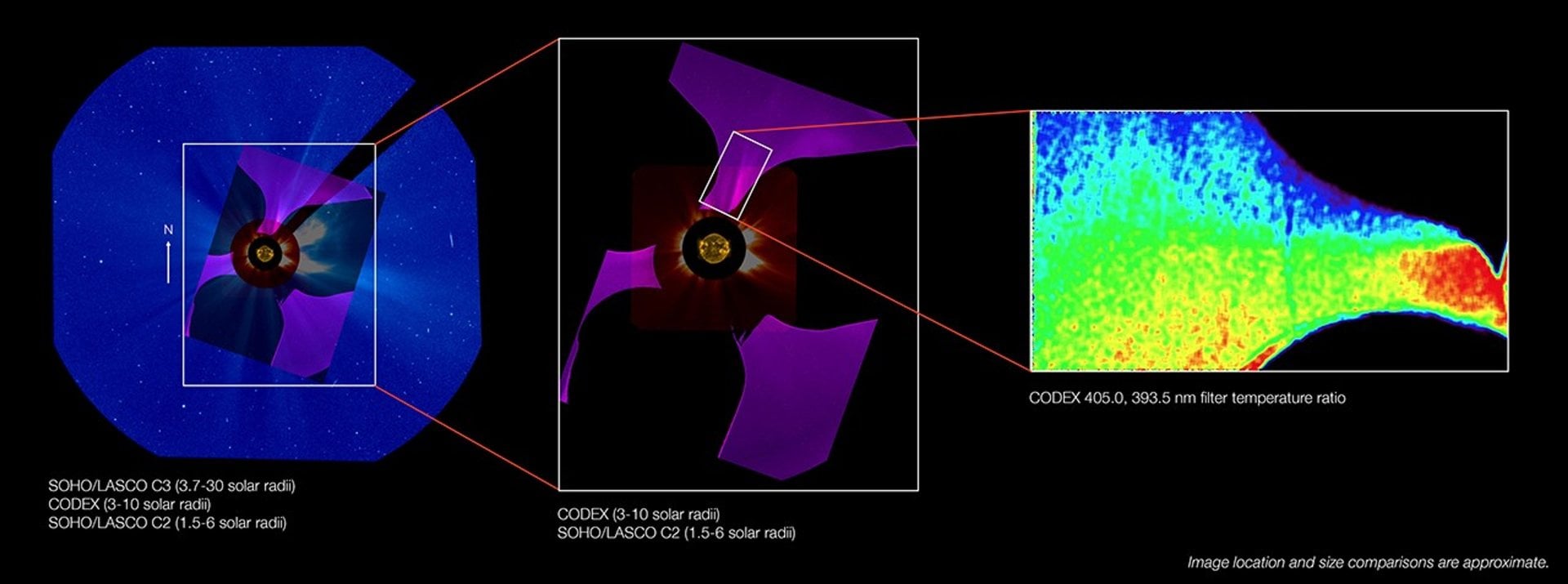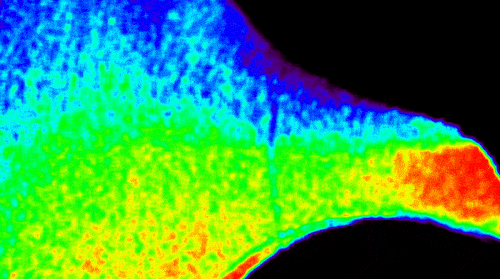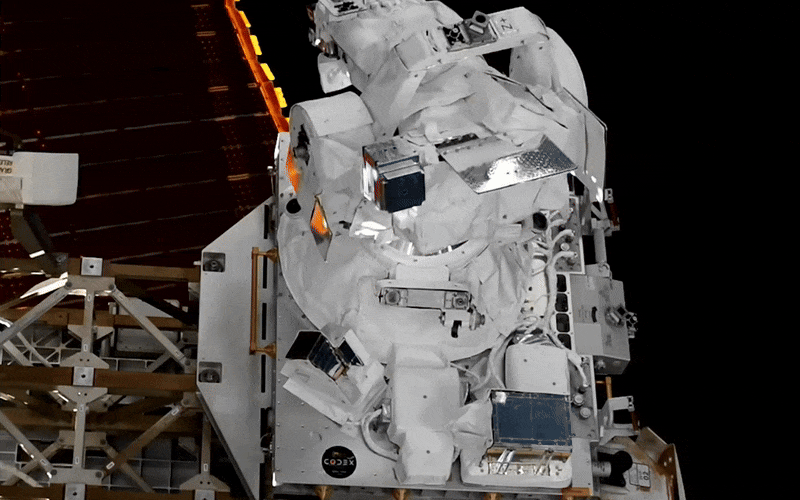A new solar observing telescope on the exterior of the International Space Station is open for business. NASA recently released images from the newly commissioned Coronal Diagnostic Experiment (CODEX) mounted on the station.
We wrote about the launch of CODEX when it was on its way to the International Space Station late last year. The new results were shared at the recent American Astronomical Society meeting, held last week in Anchorage, Alaska.
"We are excited to see some of the coronal structures and associated temperature changes, which tells us about how the Sun's corona is energized," Nicholeen Viall (NASA/GSFC) told *Universe Today*. "We are looking forward to refining our results."
CODEX was built and operated by NASA in partnership with Italy’s National Institute for Astrophysics (INAE) and KASI (The Korea Astronomy and Space Science Institute). The small telescope includes an occluding device, meant to block out the Sun, in order to observe the deep inner solar corona. About the brightness of two Full Moons, the corona is the ghostly glow you see around the Sun briefly during a total solar eclipse. This poorly understood region is thought to be the source of space weather, a place that the solar wind originates from and is first accelerated outward from the Sun. But by its very definition, this zone has been problematic to study, until now.
The occulting disk in the instrument is about the size of an outstretched hand. The chief advantage of placing a coronagraph in space is the nice sharp edges it produces, as it eliminates light spillage due to forward scattering.
 *Comparisons of CODEX's field of view with SOHO's LASCO C3 imager. Credit: NASA/ESA/SOHO/KASI/INAF/CODEX*
*Comparisons of CODEX's field of view with SOHO's LASCO C3 imager. Credit: NASA/ESA/SOHO/KASI/INAF/CODEX*
"Most solar coronagraphs actually have a series of circular occulting disks mounted along a central cylinder, which is all supported by a pylon connecting it to the outer tube of the coronagraph," says Viall. "CODEX has a similar configuration, except due to the relatively large size requirement of our coronagraph, we required three pylons. This creates the combined pattern shown in the CODEX first light images. We are working toward minimizing the stray light around the pylons."
The Science of CODEX
CODEX is the first mission to show temperature changes deep in the Sun’s atmosphere. The first results have already demonstrated that the flow within the solar corona is not homogeneous.
The multi-pass filters on CODEX are key to the instrument’s unique abilities. CODEX has four narrow-band filters—two for temperature, and two for measuring outflow speed. These allow CODEX to measure temperature changes versus the speed of moving material. This marks an improvement over just simple density readings, as was the case with early observations of the solar corona.
"We really never had the ability to do this kind of science before," says Jeffery Newmark (NASA/GSFC) in a recent press release. "The right kind of filters, the right size instrumentation--all the right things fell into place. These are brand new observations that have never been seen before, and we think there's a lot of really interesting science to be done with it."
The middle layer of the solar corona is thought to be the elusive source of the solar wind.
The source of the solar wind source links to what’s known as the coronal heating mystery mystery. Why are upper layers of the solar atmosphere hotter (by an order of a million degrees) versus the photosphere below? Some process is accelerating the solar wind to over a million kilometers per hour.
 *Temperature gradients seen in the solar corona over time by CODEX. Credit: NASA/INAF/KARI/CODEX*
*Temperature gradients seen in the solar corona over time by CODEX. Credit: NASA/INAF/KARI/CODEX*
CODEX sees the Sun about half the time, as the ISS zips around the Earth once every 90 minutes. Seasons near either solstice (such as right now, June going in to July) is what’s known as high-beta angle season for the station, allowing for near-continuous views of the Sun.
"Significant development went into the CODEX pointing system," says Viall. "It not only had to track the Sun with a few arc second precession, but account for the ISS 'jitter' or shaking. Furthermore, this system had to be automated, accounting for sunrise, sunset, as well as several additional operational constraints. The pointing system was developed by the NASA Goddard Wallops Flight Center, and derived from the Wallops Arc-Second Pointer (WASP) system developed for high-altitude scientific balloons."
 *CODEX on Earth, ahead of launch. Credit: KARI/CODEX*
*CODEX on Earth, ahead of launch. Credit: KARI/CODEX*
CODEX sees down to just 3 solar radii, versus NASA’s Parker Solar Probe at 10 solar radii. CODEX observations could also link to what ESA’s Solar Orbiter (SolO) sees with its EUV Extreme ultraviolet and white light imager, in terms of the source of the solar wind.
"We are expecting to release the data online to the public this summer at NASA's Solar Data Analysis Center." says Viall.
The mission launched on SpaceX's Cargo Dragon CRS-31 mission. Dragon arrived at the station on November 5th, and CODEX was installed by the station's Canadarm-2 on November 12th. CODEX is installed on the EXPRESS (Expedite the Processing of Experiments to the Space Station) Logistics Carrier Site 3 (ELC-3).
 *CODEX in action aboard the ISS. Credit: NASA*
*CODEX in action aboard the ISS. Credit: NASA*
The Rise of the Coronagraphs
Though it has some unique capabilities, CODEX isn’t the first coronagraph in space. The instrument is in good company in the solar-observing department. The joint ESA/NASA Solar Heliospheric Observatory (SOHO) has been observing the Sun now for over a quarter of a century. ESA’s Proba-3 was recently commissioned as well, and is now open for business, featuring the first observatory plus free-flying occulter duo. The Compact Coronagraph (CCOR-1) onboard NOAA’s GOES-19 satellite also launched last year. Also, NASA is now getting observations back from PUNCH (the Polarimeter to Unify the Corona and Heliosphere), which launched with SPHEREx on March 12th, 2025. The PUNCH quartet of instruments extends what CODEX sees, as it images out to six solar radii.
This armada of solar observatories guarantee that the ongoing Solar Cycle 25 will be the best one studied to date. CODEX puts us that much closer to unraveling the mysteries of our host star, The Sun.
 Universe Today
Universe Today
